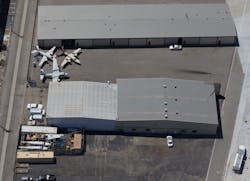Is There Turbulence Ahead? Managing Airport Reversionary Rights
At Shreveport Downtown Airport in Louisiana, long-standing problems that could jeopardize millions of dollars in future federal funding have made headlines. According to a recent Federal Aviation Administration (FAA) review of aeronautical leases, the airport sponsor has jeopardized grant assurances by failing to require tenants to comply with lease terms, including reversion clauses which address what happens to airport improvements at the termination of a lease. The FAA also found that this failure to take ownership of or remove privately built hangars on airport property has damaged or limited its ability to generate revenue necessary for airport needs.
In addition, while the FAA audit revealed that leaseholds are being improperly used as storage areas, recreation areas and even residences, tenants are refusing to honor the terms of their lease agreements. Determined to fix the issue, the airport authority is engaged in a bitter battle to run the airport as a business, make up for budget shortfalls, and change rules and regulations regarding hangar-use policies in order to protect its grant assurances.
A similar scenario is playing out at California’s Chico Airport, where the airport authority is working to add reversion clauses to all leases in order to meet the FAA’s requirements for airports to be as self-sustaining as possible. This involves enforcing a policy introduced by the city, but never enforced, that improvements made to airport property revert back to the city when a lease ends. As a result, many long-term tenants have threatened to end their leases or remove their improvements if reversionary clauses are added. The airport authority is also considering other ways to generate revenue and has deferred further discussion on the reversion clauses pending additional review of tenant leases.
Challenges to Airports
These are just two case studies that speak to a critical issue faced by airports across the nation: the option to add reversionary clauses to tenant lease agreements. What is reversion? Upon expiration of the term of a lease agreement, the ownership of the permanent improvements reverts to the airport sponsor. At this time, the tenant begins paying an improvement rent for both the land and buildings. As an alternative, the airport sponsor may require the tenant to demolish or remove improvements and return the leased premises to its original condition so that it may request proposals to develop the site. A third option is for the airport sponsor to review the opportunity to negotiate with their tenants for extended term, in exchange for capital improvements to those buildings where an improvement rent is applicable. Reversion can be a source of controversy among airport stakeholder groups. However, when managed properly, it provides the airport sponsor a stable revenue stream to achieve financial self-sustainability, in addition to well-defined lease and termination rights.
Based on current market conditions and demand, individual airports may approach the issue of reversion clauses differently. For example, airports with low demand may elect not to exercise this option, as some cities would rather have tenants manage the assets than assume obligation for capital improvements when the buildings revert. Such options may be best permit because they enable the airport sponsor to utilize their capital resources for other airport projects.
FAA Perspective
Based on the FAA’s interpretation of Grant Assurance 5 regarding reversionary interests, an airport sponsor’s failure to include or exercise lease agreement reversion clauses contributes to forfeiting its rights and powers. In addition, Grant Assurance 22 regarding economic non-discrimination requires terms, rates and fees to be established without unjust discrimination and applied uniformly to same or similar uses. Also, Grant Assurance 24 regarding fee and rental structure requires the establishment of rates, fees and rents which will make the airport as self-sustaining as possible. Thus, failure to include or exercise reversion clauses in a lease agreement impacts the airport sponsor’s ability to achieve or maintain self-sustainability.
Overall, the FAA has found that failure to exercise reversion clauses in leases has contributed to forfeiting an airport’s rights, powers and ability to be self-sustainable. Failure to apply best practices or obligatory requirements places the airport at risk for future FAA grant funding. With that said, an extended lease term should not be an issue if aeronautical rent for land and improvements are at comparable fair market value.
Managing Reversion Rights
Airport sponsors should assume a proactive approach to managing and tracking the issue of reversion rights. First, consider stakeholder input and foster communication with state and federal agencies in advance. Second, consider engaging a professional engineer or building inspector to prepare “standard of condition assessment” language and inserting a regular maintenance requirement in all leases. Third, provide annual updates to tenants on insurance requirements, rental adjustments, lease term expiration dates and reversion requirements.
The number of years remaining on the term of a lease may also impact the airport sponsor’s handling of reversion rights. If there are three to five years remaining on a lease, start by analyzing and qualifying what buildings are eligible for extended terms. Next, consider an extended lease term in exchange for capital investments. If the airport plans to assume the improved leasehold, consider initiating a competitive request for proposals process. Finally, determine whether it should be required for the improvements to be demolished or removed.
For a lease with less than three years remaining and no extension, the airport sponsor should conduct a detailed inspection and establish a condition report. Second, require the tenant to provide corrective actions and copies of all records. Finally, require a detailed demolition plan and how the site is to be vacated.
Clearly, the issue of airport reversion rights can be contentious. It is vitally important for airport sponsors to know their market and to plan for long-term financial sustainability. Strive to establish a strong foundation before moving forward and be certain to align goals with local elected officials and stakeholders. Above all, communicate, collaborate and be open to creativity, negotiation and compromise.
Curt Castagna, president and CEO of Aeroplex/Aerolease Group, is a member of the Los Angeles County Airport Commission, president of the Van Nuys and Long Beach Airport Associations, and a board member of the National Air Transportation Association. A certified private and instrument-rated pilot, he has instructed courses in aviation administration at Cal State Los Angeles for over two decades.
About the Author

Curt Castagna
President and CEO
Curt Castagna, President/CEO of Ascension Group Partners, serves as president and CEO of the National Air Transportation Association, member and past chair of the Los Angeles County Airport Commission, and president of the Van Nuys and Long Beach airport associations. A certified private, seaplane and instrument-rated pilot, he continues to instruct courses in aviation administration at Cypress Community College and Cal State Los Angeles.
